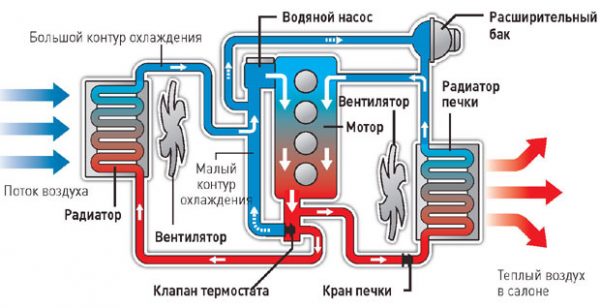
Device, operation and troubleshooting of the VAZ 2106 cooling system
Content
A good cooling system is essential to the smooth operation of any vehicle's engine. VAZ 2106 is no exception. Failure of one or more elements of the system can lead to overheating of the engine and, as a result, to costly repairs. Therefore, timely maintenance and repair of the cooling system is extremely important.
Cooling system VAZ 2106
When driving any car, including the VAZ 2106, in operating mode, the engine heats up to 85–90 ° C. The temperature is recorded by a sensor that transmits signals to the instrument panel. To prevent possible overheating of the power unit, a cooling system filled with coolant (coolant) is designed. As a coolant, antifreeze (antifreeze) is used, which circulates through the internal channels of the cylinder block and cools it.
Purpose of the cooling system
Separate elements of the engine heat up quite strongly during operation, and it becomes necessary to remove excess heat from them. In the operating mode, a temperature of the order of 700–800 ˚С is created in the cylinder. If heat is not removed forcibly, jamming of rubbing elements, in particular, the crankshaft, may occur. To do this, antifreeze circulates through the engine cooling jacket, the temperature of which decreases in the main radiator. This allows you to operate the engine almost continuously.

Cooling parameters
The main characteristics of the cooling system are the type and amount of coolant necessary for the smooth operation of the engine, as well as the operating pressure of the fluid. According to the operating instructions, the VAZ 2106 cooling system is designed for 9,85 liters of antifreeze. Therefore, when replacing, you should purchase at least 10 liters of coolant.
The operation of the engine involves the expansion of antifreeze in the cooling system. To normalize the pressure in the radiator cap, two valves are provided, working for inlet and outlet. When the pressure rises, the exhaust valve opens and the excess coolant enters the expansion tank. When the engine temperature drops, the volume of antifreeze decreases, a vacuum is created, the intake valve opens and the coolant flows back into the radiator.
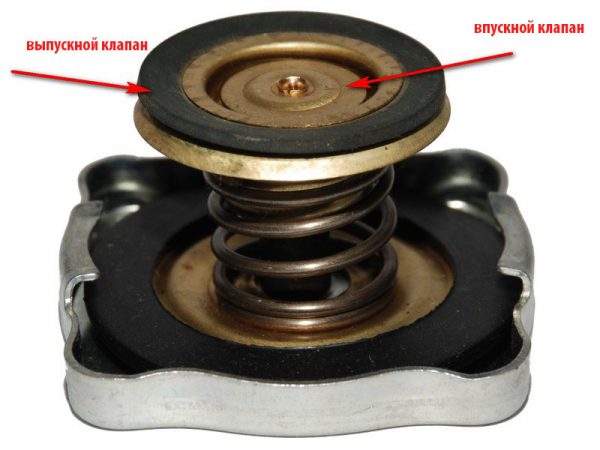
This allows you to maintain normal coolant pressure in the system under any engine operating conditions.
Video: pressure in the cooling system
The device of the cooling system VAZ 2106
The cooling system of the VAZ 2106 consists of the following elements:
- radiator;
- radiator cap;
- branch pipes;
- thermostat;
- expansion tank;
- water pump.
The failure of any element leads to a slowdown or cessation of coolant circulation and a violation of the thermal regime of the engine.
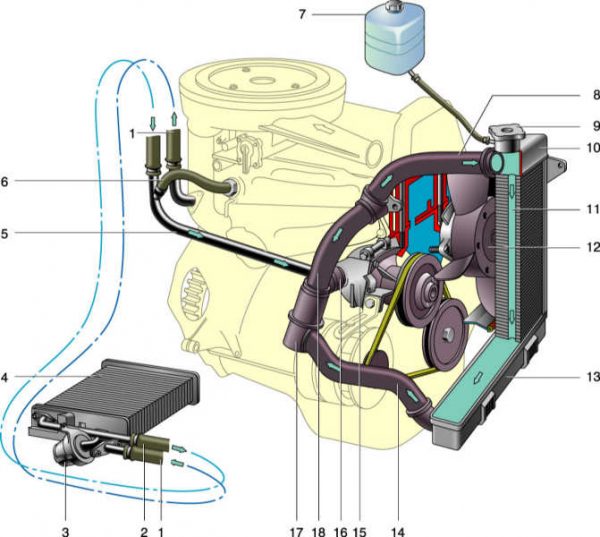

In addition to the listed components and parts, the cooling system includes a heating radiator and a stove tap. The first is designed to heat the passenger compartment, and the second is to stop the coolant supply to the stove radiator in the warm season.
Cooling system radiator
The antifreeze heated by the engine is cooled in the radiator. The manufacturer installed two types of radiators on the VAZ 2106 - copper and aluminum, consisting of the following parts:
- upper tank;
- lower tank;
- cooling cells.
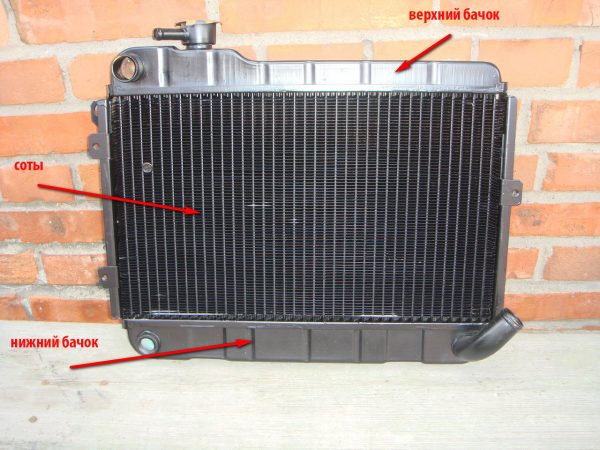

The upper tank is equipped with a filler neck, in which, when the engine is running, hot antifreeze accumulates after one cycle of circulation. From the coolant neck, through the radiator cells, it passes into the lower tank, being cooled by a fan, and then again enters the cooling jacket of the power unit.
At the top and bottom of the device there are branches for branch pipes - two large diameters and one small. A narrow hose connects the radiator to the expansion tank. A thermostat is used as a valve to regulate the coolant flow in the system, with which the radiator is connected through a wide upper pipe. The thermostat changes the direction of antifreeze circulation - to the radiator or cylinder block.
Forced coolant circulation is carried out using a water pump (pump), which directs antifreeze under pressure into channels (cooling jacket) specially provided in the engine block housing.
Radiator malfunctions
Any malfunction of the radiator leads to an increase in coolant temperature and, as a result, to a possible overheating of the engine. The main problems are antifreeze leakage through cracks and holes resulting from mechanical damage or corrosion, and internal clogging of the radiator tubes. In the first case, the copper heat exchanger is restored quite simply. It is much more difficult to repair an aluminum radiator, since an oxide film forms on the metal surface, which makes soldering and other methods of repairing damaged areas difficult. Therefore, when a leak occurs, aluminum heat exchangers are usually immediately replaced with new ones.
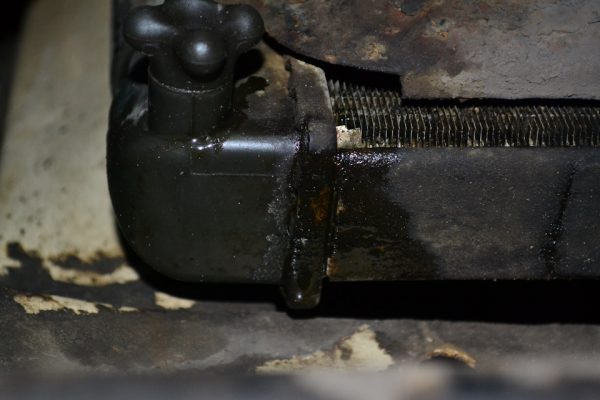

Cooling fan
The fan of the VAZ 2106 cooling system can be mechanical and electromechanical. The first is mounted on the pump shaft with four bolts through a special flange and is driven by a belt connecting the crankshaft pulley to the pump pulley. The electromechanical fan is turned on/off when the temperature sensor contacts are closed/opened. Such a fan is mounted as one piece with the electric motor and attached to the radiator using a special frame.
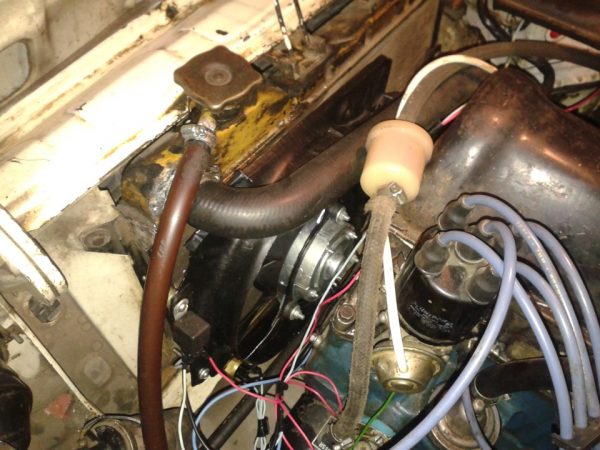

If earlier the fan was powered through a temperature sensor, now it is supplied through the contacts of the sensor-switch. The fan motor is a DC motor with permanent magnet excitation. It is installed in a special casing, fixed on the radiator of the cooling system. During operation, the motor does not require any maintenance, and in case of failure it must be replaced.
Fan on sensor
Failure of the fan on sensor (DVV) can lead to very serious consequences. When the temperature rises to a critical level, the fan will not turn on, which, in turn, will lead to engine overheating. Structurally, DVV is a thermistor that closes the fan contacts when the coolant temperature rises to 92 ± 2 ° C and opens them when the temperature drops to 87 ± 2 ° C.


DVV VAZ 2106 differs from VAZ 2108/09 sensors. The latter are switched on at a higher temperature. You should pay attention to this when buying a new sensor.
DVV in the car can be located:
- from below on the left side of the brass radiator tank;
- at the bottom of the right tank of the aluminum radiator.
Wiring diagram for switching on the fan
The circuit for switching on the fan of the VAZ 2106 cooling system consists of:
- electric motor;
- relay;
- fuse;
- sensor;
- power buttons.
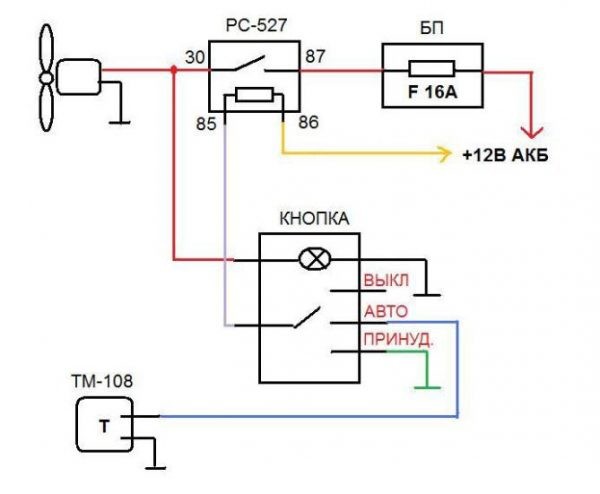

Conclusion of turning on the fan on a separate button
The expediency of outputting the fan on to a separate button in the cabin is due to the following. DVV can fail at the most inopportune moment (especially in hot weather), and with the help of a new button it will be possible to supply power directly to the fan, bypassing the sensor, and avoid engine overheating. To do this, it is necessary to include an additional relay in the fan power circuit.
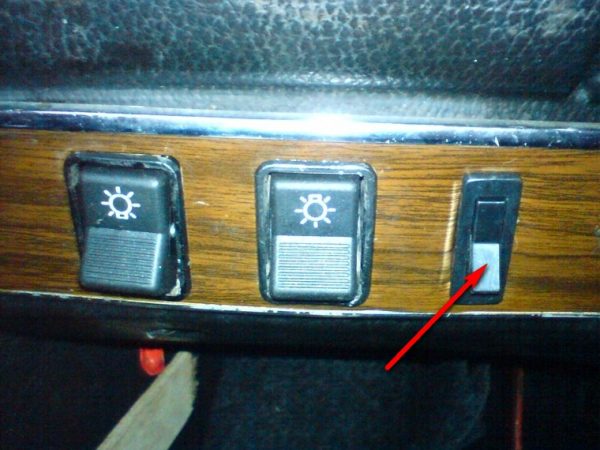

To complete the work you will need:
- terminals "father" and "mother";
- insulating tape;
- wires (7 m);
- pliers;
- openings.
The fan switch is installed in the following order:
- We remove the negative terminal from the battery.
- We disconnect and bite off one of the terminals of the switch-on sensor.
- We clamp the regular and new wire into the new terminal and isolate the connection with electrical tape.
- We lay the wire into the cabin through the engine compartment so that it does not interfere with anything. This can be done both from the side of the dashboard, and by drilling a hole from the side of the glove compartment.
- We fix the relay near the battery or in another suitable place.
- We prepare a hole for the button. We choose the installation location at our discretion. Easy to mount on the dashboard.
- We mount and connect the button in accordance with the diagram.
- We connect the terminal to the battery, turn on the ignition and press the button. The fan should start running.
Video: forcing the cooling fan to turn on with a button in the cabin


Watch this video on YouTube
The implementation of such a scheme will allow the cooling system fan to be turned on regardless of the coolant temperature.
Water pump
The pump is designed to provide forced circulation of coolant through the cooling system. If it fails, the movement of antifreeze through the cooling jacket will stop, and the engine will begin to overheat. The VAZ 2106 pump is a centrifugal type pump with a steel or plastic impeller, the rotation of which at high speed causes the coolant to circulate.
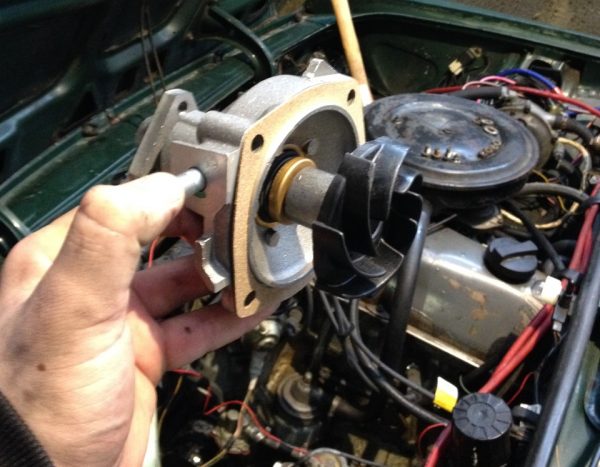

Pump malfunctions
The pump is considered a fairly reliable unit, but it can also fail. Its resource depends both on the quality of the product itself and on the operating conditions. Pump failures can be minor. Sometimes, to restore its performance, it is enough to replace the oil seal. In other cases, for example, if the bearing fails, it will be necessary to replace the entire pump. As a result of bearing wear, it can jam, and engine cooling will stop. It is not recommended to continue driving in this case.
Most owners of the VAZ 2106, if problems arise with the water pump, replace it with a new one. Repair of a faulty pump is usually impractical.
Thermostat
The VAZ 2106 thermostat is designed to adjust the temperature regime of the power unit. On a cold engine, the coolant circulates in a small circle, including the stove, engine cooling jacket and pump. When the antifreeze temperature rises to 95˚С, the thermostat opens a large circulation circle, which, in addition to the indicated elements, includes a cooling radiator and an expansion tank. This provides a quick warm-up of the engine to operating temperature and extends the service life of its components and parts.


Thermostat malfunctions
The most common thermostat malfunctions:
- the valve does not open;
- valve does not close completely.
The cause of the first situation is usually a stuck valve. In this case, the temperature gauge enters the red zone, and the radiator of the cooling system remains cold. It is not recommended to continue driving with such a malfunction - overheating can damage the cylinder head gasket, deform the head itself or cause cracks in it. If it is not possible to replace the thermostat, you should remove it on a cold engine and connect the pipes directly. This will be enough to get to the garage or car service.
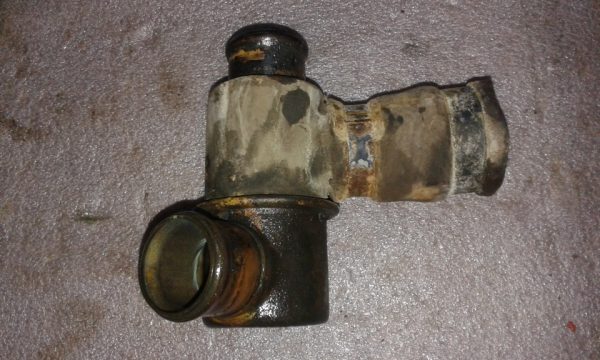

If the thermostat valve does not close completely, then most likely debris or some foreign object has got inside the device. In this case, the temperature of the radiator will be the same as the thermostat housing, and the interior will warm up very slowly. As a result, the engine will not be able to reach operating temperature, and the wear of its elements will accelerate. The thermostat must be removed and inspected. If it is not clogged, it should be replaced with a new one.
Expansion tank
The expansion tank is designed to receive coolant expanding when heated and control its level. The min and max marks are applied to the container, by which one can judge the level of antifreeze and the tightness of the system. The amount of coolant in the system is considered optimal if its level in the expansion tank on a cold engine is 30–40 mm above the min mark.
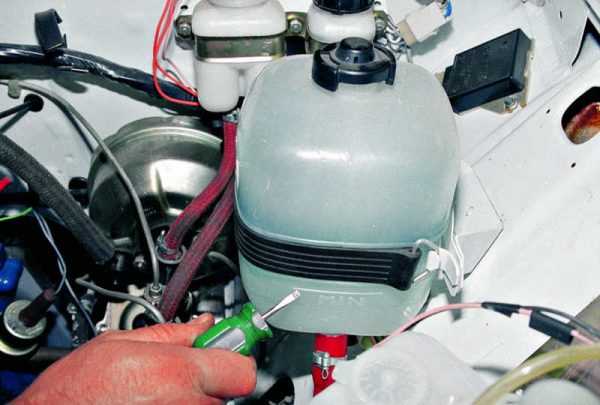

The tank is closed with a lid with a valve that allows you to equalize the pressure in the cooling system. When the coolant expands, a certain amount of steam comes out of the tank through the valve, and when cooled, air enters through the same valve, preventing vacuum.
Location of the expansion tank VAZ 2106
The expansion tank VAZ 2106 is located in the engine compartment on the left side near the windshield washer fluid container.
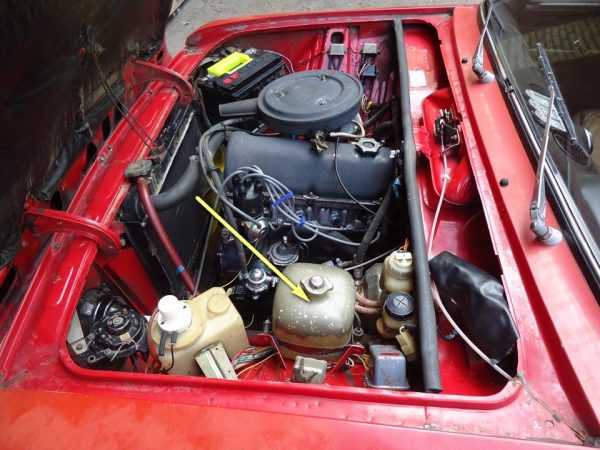

The principle of operation of the expansion tank
As the engine warms up, the coolant volume increases. Excess coolant enters a specially designated container. This allows the expansion of antifreeze to avoid the destruction of the elements of the cooling system. The expansion of the liquid can be judged by the marks on the body of the expansion tank - on a hot engine, its level will be higher than on a cold one. When the engine cools, on the contrary, the coolant volume decreases, and the antifreeze again begins to flow from the tank to the radiator of the cooling system.
Cooling system pipes
The pipes of the cooling system are designed for hermetic connection of its individual elements and are large-diameter hoses. On the VAZ 2106, with their help, the main radiator is connected to the engine and thermostat, and the stove with the cooling system.
Spigot types
During the operation of the car, it is necessary to periodically check the hoses for leakage of antifreeze. The pipes themselves may be intact, but due to the loosening of the clamps, a leak may appear at the joints. All pipes with traces of damage (cracks, ruptures) are subject to unconditional replacement. A set of pipes for the VAZ 2106 consists of:
- upper inlet pipe;
- outlet pipe;
- thermostat and pump couplings;
- thermostat bypass hose.
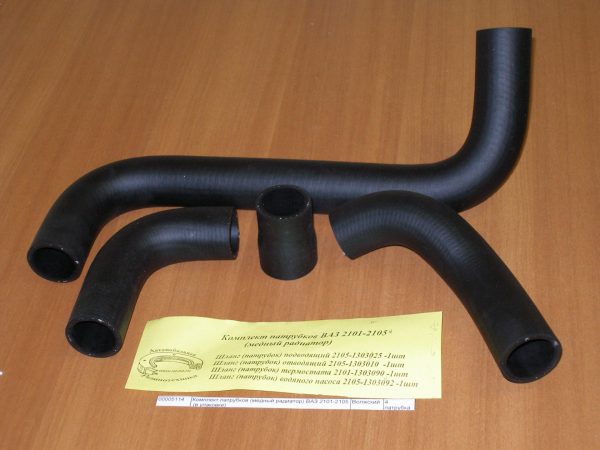

The fittings differ depending on the type of radiator installed. The lower taps of the copper radiator have a shape different from the aluminum one. The branch pipes are made of rubber or silicone and are reinforced with a metal thread to increase reliability and durability. Unlike rubber, silicone have several reinforced layers, but their cost is much higher. The choice of the type of pipes depends only on the wishes and capabilities of the car owner.


Replacing nozzles
If the nozzles are damaged, they must in any case be replaced with new ones. They are also changed during the repair of the cooling system and its elements. Replacing the pipes is quite simple. All work is carried out on a cold engine with a minimum coolant pressure in the system. Use a Phillips or flathead screwdriver to loosen the clamp and slide it to the side. Then, pulling or twisting from side to side, remove the hose itself.
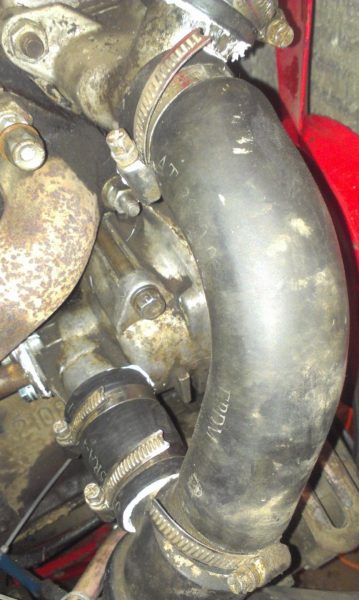

Before installing new hoses, the seats and the hoses themselves are cleaned of dust and dirt. If necessary, replace the old clamps with new ones. A sealant is applied to the outlet, then a hose is put on it and the clamp is tightened.
Video: replacing cooling system pipes


Watch this video on YouTube
Coolant for VAZ 2106
The main purpose of antifreeze is engine cooling. In addition, the coolant temperature can be used to judge the condition of the engine. To perform these tasks correctly, antifreeze must be updated in a timely manner.


The main functions of the coolant:
- maintaining the operating temperature of the engine;
- supply of warm air to the cabin in winter;
- water pump lubrication.
The choice of coolant for the VAZ 2106
The cooling system of the VAZ 2106 involves replacing the coolant every 45 thousand kilometers or once every two years. This is necessary, since antifreeze loses its original properties during operation.
When choosing a coolant, the year of manufacture of the car should be taken into account.
Table: antifreeze for VAZ 2106
| Year | A type | Color | Lifetime | Recommended manufacturers |
| 1976 | TL | blue | 2 years | Prompek, Speedol Super Antifreeze, Oil-40 |
| 1977 | TL | blue | 2 years | AGA-L40, Speedol Super Antifreeze, Sapfire |
| 1978 | TL | blue | 2 years | Lukoil Super A-40, Tosol-40 |
| 1979 | TL | blue | 2 years | Alaska A-40M, Felix, Speedol Super Antifriz, Tosol-40 |
| 1980 | TL | blue | 2 years | Prompek, Speedol Super Antifreeze, Oil-40 |
| 1981 | TL | blue | 2 years | Felix, Prompek, Speedol Super Antifreeze, Tosol-40 |
| 1982 | TL | blue | 2 years | Lukoil Super A-40, Tosol-40 |
| 1983 | TL | blue | 2 years | Alaska A-40M, Sapfire, Anticongelante Gonher HD, Tosol-40 |
| 1984 | TL | blue | 2 years | Sapfire, Oil-40, Alaska A-40M, AGA-L40 |
| 1985 | TL | blue | 2 years | Felix, Prompek, Speedol Super Antifreeze, Sapfire, Oil-40 |
| 1986 | TL | blue | 2 years | Lukoil Super A-40, AGA-L40, Sapfire, Tosol-40 |
| 1987 | TL | blue | 2 years | Alaska A-40M, AGA-L40, Sapfire |
| 1988 | TL | blue | 2 years | Felix, AGA-L40, Speedol Super Antifreeze, Sapfire |
| 1989 | TL | blue | 2 years | Lukoil Super A-40, Oil-40, Speedol Super Antifreeze, Sapfire |
| 1990 | TL | blue | 2 years | Tosol-40, AGA-L40, Speedol Super Antifriz, Gonher HD Antifreeze |
| 1991 | G11 | green | 3 years | Glysantin G 48, Lukoil Extra, Aral Extra, Mobil Extra, Zerex G, EVOX Extra, Genantin Super |
| 1992 | G11 | green | 3 years | Lukoil Extra, Zerex G, Castrol NF, AWM, GlycoShell, Genantin Super |
| 1993 | G11 | green | 3 years | Glysantin G 48, Havoline AFC, Nalcool NF 48, Zerex G |
| 1994 | G11 | green | 3 years | Mobil Extra, Aral Extra, Nalcool NF 48, Lukoil Extra, Castrol NF, GlycoShell |
| 1995 | G11 | green | 3 years | AWM, EVOX Extra, GlycoShell, Mobil Extra |
| 1996 | G11 | green | 3 years | Havoline AFC, Aral Extra, Mobile Extra, Castrol NF, AWM |
| 1997 | G11 | green | 3 years | Aral Extra, Genantin Super, G-Energy NF |
| 1998 | G12 | red | 5 years | GlasElf, AWM, MOTUL Ultra, G-Energy, Freecor |
| 1999 | G12 | red | 5 years | Castrol SF, G-Energy, Freecor, Lukoil Ultra, GlasElf |
| 2000 | G12 | red | 5 years | Freecor, AWM, MOTUL Ultra, Lukoil Ultra |
| 2001 | G12 | red | 5 years | Lukoil Ultra, Motorcraft, Chevron, AWM |
| 2002 | G12 | red | 5 years | MOTUL Ultra, MOTUL Ultra, G-Energy |
| 2003 | G12 | red | 5 years | Chevron, AWM, G-Energy, Lukoil Ultra, GlasElf |
| 2004 | G12 | red | 5 years | Chevron, G-Energy, Freecor |
| 2005 | G12 | red | 5 years | Havoline, MOTUL Ultra, Lukoil Ultra, GlasElf |
| 2006 | G12 | red | 5 years | Havoline, AWM, G-Energy |
Draining the coolant
Draining the coolant is necessary when replacing it or during some repair work. It's pretty easy to do this:
- With the engine cold, open the radiator cap and expansion tank cap.
- We substitute a suitable container with a volume of about 5 liters under the radiator tap and unscrew the tap.
- To completely drain the coolant from the system, we substitute the container under the drain hole and unscrew the bolt-plug on the engine.
If there is no need for a complete drain, then the last step can be omitted.
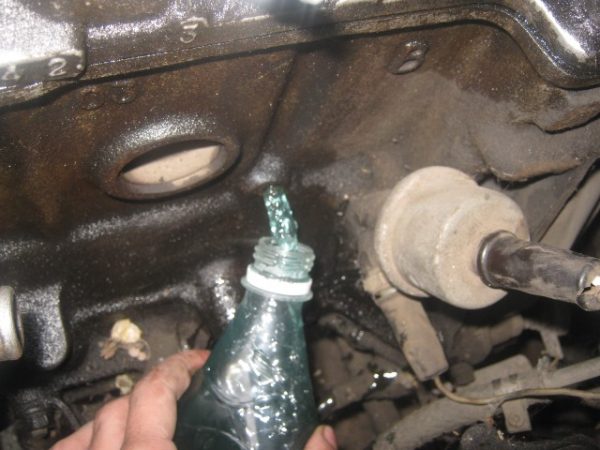

Flushing the cooling system
If the stove does not work well or the entire cooling system functions intermittently, you can try to flush it. Some car owners find this procedure very effective. For washing, you can use special cleaning products (MANNOL, HI-GEAR, LIQUI MOLY, etc.) or limit yourself to what is available (for example, citric acid solution, Mole plumbing cleaner, etc.).
Before washing with folk remedies, you need to drain the antifreeze from the cooling system and fill it with water. Then you need to start the engine, let it run for a while and drain the fluid again - this will remove debris and impurities. If the system is periodically cleaned and slightly contaminated, then it can be washed with clean water without the addition of special products.


It is recommended to separately flush the radiator and engine cooling jacket. When flushing the radiator, the lower pipe is removed and a hose with running water is put on the outlet, which will begin to flow from above. In the cooling jacket, on the contrary, water is supplied through the upper branch pipe, and is discharged through the lower one. Flushing is continued until clean water begins to flow from the radiator.
To remove accumulated scale from the system, you can use citric acid at the rate of 5 sachets of 30 g for the entire cooling system. The acid dissolves in boiling water, and the solution is diluted already in the cooling system. After that, the engine must be allowed to run at high speeds or just drive, controlling the coolant temperature. After draining the acid solution, the system is washed with clean water and filled with coolant. Despite the cheapness, citric acid cleans the cooling system quite effectively. If the acid did not cope with the pollution, you will have to use expensive branded products.
Video: flushing the cooling system VAZ 2106


Watch this video on YouTube
Filling the coolant into the system
Before pouring antifreeze, close the radiator valve of the cooling system and tighten the bolt plug on the cylinder block. The coolant is first poured into the radiator along the lower edge of the neck, and then into the expansion tank. To prevent air bubbles from forming in the cooling system, the liquid is poured in a thin stream. In this case, it is recommended to raise the expansion tank above the engine. During the filling process, you need to make sure that the coolant has reached the edge without air. After that, close the radiator cap and check the fluid level in the tank. Then they start the engine, warm it up and check the operation of the stove. If the stove is working properly, then there is no air in the system - the work was done efficiently.
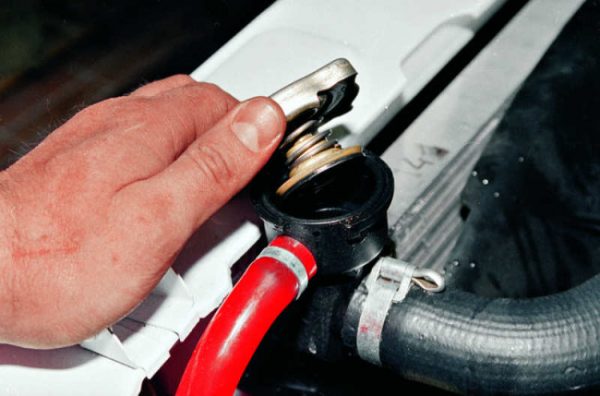

Interior heating system VAZ 2106
The VAZ 2106 interior heating system consists of the following elements:
- stove radiator;
- stove tap;
- stove fan motor;
- damper and duct system.
With the help of the stove in the winter, a comfortable microclimate is created and maintained in the car interior. Hot coolant passes through the heater core and heats it up. The radiator is blown by a fan, the air from the street heats up and enters the cabin through the air duct system. The intensity of air flow is regulated by dampers and by changing the fan speed. The stove can operate in two modes - with maximum and minimum power. In the warm season, you can turn off the coolant supply to the stove radiator with a tap.
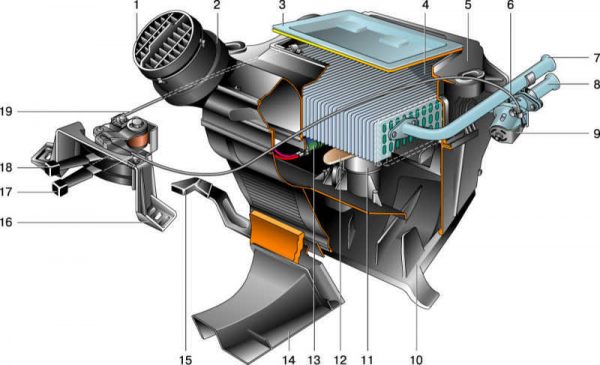

Coolant temperature gauge
The coolant temperature gauge on the VAZ 2106 receives information from a temperature sensor installed in the cylinder head. Moving the arrow into the red zone indicates problems in the cooling system and the need to eliminate these problems. If the arrow of the device is constantly in the red zone (for example, with the ignition on), then the temperature sensor has failed. A malfunction of this sensor can also lead to the pointer of the device freezing at the beginning of the scale and not moving as the engine heats up. In both cases, the sensor must be replaced.
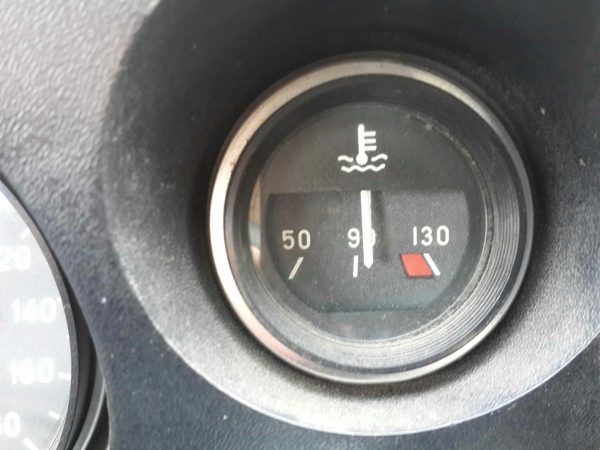

Tuning the cooling system VAZ 2106
Some owners of the VAZ 2106 are attempting to refine the cooling system by making changes to the standard design. So, if the car is equipped with a mechanical fan, during long periods of inactivity in urban traffic jams, the coolant begins to boil. This problem is typical for vehicles equipped with a conventional mechanical fan. The problem is solved by installing an impeller with a large number of blades or replacing the fan with an electric one.


Another option to increase the efficiency of the VAZ 2106 cooling system is to install a radiator from the VAZ 2121 with a larger heat exchange area. In addition, it is possible to speed up the coolant circulation in the system by installing an additional electric pump. This will positively affect not only the interior heating in winter, but also the antifreeze cooling on hot summer days.
Thus, the VAZ 2106 cooling system is quite simple. Any of its malfunctions can lead to sad consequences for the owner, up to a major overhaul of the engine. However, even a novice motorist can perform most of the work on the diagnosis, repair and maintenance of the cooling system.

